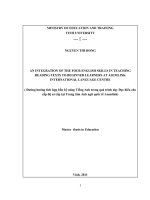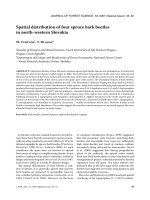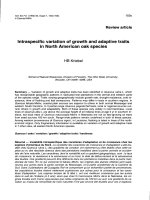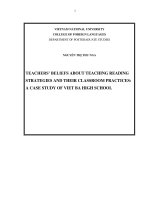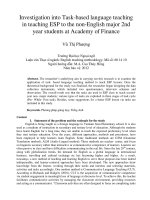The conservatism of the early English colonists in North
Bạn đang xem bản rút gọn của tài liệu. Xem và tải ngay bản đầy đủ của tài liệu tại đây (48.6 KB, 12 trang )
Practice Test A – Reading
Line
(5)
(10)
(15)
(20)
(25)
Question 1- 10
The conservatism of the early English colonists in North America, their strong
attachment to the English way of doing things, would play a major part in the furniture
that was made in New England. The very tools that the first New England furniture
makers used were, after all, not much different from those used for centuries – even
millennia: basic hammers, saws, chisels, planes, augers, compasses, and measures.
These were the tools used more or less by all people who worked with wood:
carpenters, barrel makers, and shipwrights. At most the furniture makers might have
had planes with special edges or more delicate chisels, but there could not have been
much specialization in the early years of the colonies.
The furniture makers in those early decades of the 1600’s were known as “joiners,”
for the primary method of constructing furniture, at least among the English of this
time, was that of mortise-and-tenon joinery. The mortise is the hole chiseled and cut
into one piece of wood, while the tenon is the tongue or protruding element shaped
from another piece of wood so that it fits into the mortise; and another small hole is
then drilled (with the auger) through the mortised end and the tenon so that a whittled
peg can secure the joint – thus the term “joiner.” Panels were fitted into slots on the
basic frames. This kind of construction was used for making everything from houses to
chests.
Relatively little hardware was used during this period. Some nails – forged by
hand – were used, but no screws or glue. Hinges were often made of leather, but metal
hinges were also used. The cruder varieties were made by blacksmiths in the colonies,
but the finer metal elements were imported. Locks and escutcheon plates – the latter to
shield the wood from the metal key – would often be imported.
Above all, what the early English colonists imported was their knowledge of,
familiarity with, and dedication to the traditional types and designs of furniture they
knew in England.
1. The phrase “attachment to” in line 2 is
closest in meaning to
(A) control of
(B) distance from
(C) curiosity about
(D) preference for
2. The word “protruding” in line 13 is
closest in meaning to
(A) parallel
(B) simple
(C) projecting
(D) important
3. The relationship of a mortise and a
tenon is most similar to that of
(A) a lock and a key
(B) a book and its cover
(C) a cup and a saucer
(D) a hammer and a nail
4. For what purpose did woodworkers
use an auger
(A) To whittle a peg
(B) To make a tenon
(C) To drill a hole
(D) To measure a panel
5. Which of the following were NOT used
in the construction of colonial
furniture?
(A) Mortises
(B) Nails
(C) Hinges
(D) Screws
6. The author implies that colonial
metalworkers were
(A) unable to make elaborate parts
(B) more skilled than woodworkers
(C) more conservative than other
colonists
(D) frequently employed by joiners
7. The word “shield” in line 23 is closest
in meaning to
(A) decorate
(B) copy
(C) shape
(D) protect
8. The word “they” in line 25 refers to
(A) designs
(B) types
(C) colonists
(D) all
9. The author implies that the colonial
joiners
(A) were highly paid
(B) based their furniture on English
models
(C) used many specialized tools
(D) had to adjust to using new kinds
of wood in New England
10. Which of the following terms does the
author explain in the passage?
(A) “millennia” (line 5)
(B) “joiners” (line 10)
(C) “whittled” (line 15)
(D) “blacksmiths” (line 21)
Line
(5)
(10)
(15)
(20)
(25)
Question 11 – 20
In addition to their military role, the forts of the nineteenth century provided numerous
other benefits for the American West. The establishment of these posts opened new
roads and provided for the protection of daring adventurers and expeditions as well as
established settlers. Forts also served as bases where enterprising entrepreneurs could
bring commerce to the West, providing supplies and refreshments to soldiers as well as to
pioneers. Posts like Fort Laramie provided supplies for wagon trains traveling the
natural highways toward new frontiers. Some posts became stations for the pony
express; still others, such as Fort Davis, were stagecoach stops for weary travelers. All
of these functions, of course, suggest that the contributions of the forts to the
civilization and development of the West extended beyond patrol duty.
Through the establishment of military posts, yet other contributions were made to the
development of western culture. Many posts maintained libraries or reading rooms,
and some – for example, Fort Davis – had schools. Post chapels provided a setting
for religious services and weddings. Throughout the wilderness, post bands provided
entertainment and boosted morale. During the last part of the nineteenth century, to
reduce expenses, gardening was encouraged at the forts, thus making experimental
agriculture another activity of the military. The military stationed at the various forts
also played a role in civilian life by assisting in maintaining order, and civilian officials
often called on the army for protection.
Certainly, among other significant contributions the army made to the improvement
of the conditions of life was the investigation of the relationships among health,
climate, and architecture. From the earliest colonial times throughout the nineteenth
century, disease ranked as the foremost problem in defense. It slowed construction of
forts and inhibited their military functions. Official documents from many regions
contained innumerable reports of sickness that virtually incapacitated entire garrisons.
In response to the problems, detailed observations of architecture and climate and their
relationships to the frequency of the occurrence of various diseases were recorded at
various posts across the nation by military surgeons.
11. Which of the following statements best
expresses the main idea of the
passage?
(A) By the nineteenth century, forts
were no longer used by the
military.
(B) Surgeons at forts could not
prevent outbreaks of disease.
(C) Forts were important to the
development of the American
West
(D) Life in nineteenth-century forts
was very rough.
12. The word “daring” in line 3 is closest
in meaning to
(A) lost
(B) bold
(C) lively
(D) foolish
13. Which of the following would a
traveler be likely be LEAST likely to
obtain at Fort Laramie?
(A) Fresh water
(B) Food
(C) Formal clothing
(D) Lodging
14. The word “others” in line 8 refers to
(A) posts
(B) wagon trains
(C) frontiers
(D) highways
15. The word “boosted” in line 15 is
closest in meaning to
(A) influenced
(B) established
(C) raised
(D) maintained
16. Which of the following is the most
likely inference about the decision to
promote gardening at forts?
(A) It was expensive to import
produce from far away.
(B) Food brought in from outside
was often spoiled
(C) Gardening was a way to occupy
otherwise idle soldiers.
(D) The soil near the forts was very
fertile.
17. According to the passage, which of
the following posed the biggest
obstacle to the development of
military forts?
(A) Insufficient shelter
(B) Shortage of materials
(C) Attacks by wild animals
(D) Illness
18. The word “inhibited” in line 24 is
closest in meaning to
(A) involved
(B) exploited
(C) united
(D) hindered
19. How did the military assists in the
investigation of health problems?
(A) By registering annual birth and
death rates
(B) By experiments with different
building materials
(C) By maintaining records of
diseases and potential causes
(D) By monitoring the soldiers’ diets
20. The author organizes the discussion
of forts by
(A) describing their locations
(B) comparing their sizes
(C) explaining their damage to the
environment
(D) listing their contributions to
western life
Line
(5)
(10)
(15)
(20)
(25)
Question 21 – 30
Anyone who has handled a fossilized bone knows that it is usually not exactly like
its modern counterpart, the most obvious difference being that it is often much heavier.
Fossils often have the quality of stone rather than of organic materials, and this has led
to the use of the term “petrifaction” (to bring about rock). The implication is that bone,
and other tissues, have somehow been turned into stone, and this is certainly the
explanation given in some texts. But it is wrong interpretation; fossils are frequently
so dense because the pores and other spaces in the bone have become filled with
minerals taken up from the surrounding sediments. Some fossil bones have all the
interstitial spaces filled with foreign minerals, including the marrow cavity, if there is
one, while others have taken up but little from their surroundings. Probably all of the
minerals deposited within the bone have been recrystallized from solution by the action
of water percolating thru them. The degree of mineralization appears to be determined
by the nature of the environment in which the bone was deposited and not by the
antiquity of the bone. For example, the black fossil bones that are so common in many
parts of Florida are heavily mineralized, but they are only about 20,000 years old,
whereas many of the dinosaur bones from western Canada, which are about 75 million
years old, are only partially filled in. Under optimum conditions the process of
mineralization probably takes thousands rather than millions of years, perhaps
considerably less.
The amount of change that has occurred in fossil bone, even in bone as old as that of
dinosaurs, is often remarkably small. We are therefore usually able to see the
microscopic structures of the bone, including such fine details as the lacunae where the
living bone cells once resided. The natural bone mineral, the hydroxyapatite, is
virtually unaltered too – it has the same crystal structure as that of modern bone.
Although nothing remains of the original collagen, some of its component amino acids
are usually still detectable, together with amino acids of the noncollagen proteins of bone.
21. What does the passage mainly
discuss?
(A) The location of fossils in North
America
(B) The composition of fossils
(C) Determining the size and weight
of fossils
(D) Procedures for analyzing fossils
22. The word “counterpart” in line 2 is
closest in meaning to
(A) species
(B) version
(C) change
(D) material

